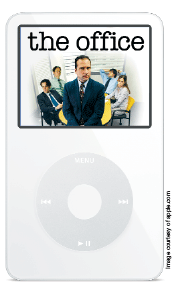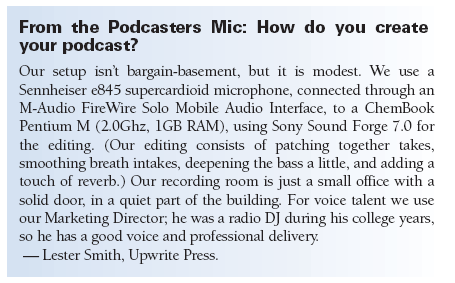The Art & Science of Podcasting

| More than just the latest marketing buzzword, podcasting presents a legitimate opportunity to share a message with a global, yet specific audience. And, these potential customers are volunteering to hear your message. They are a savvy audience - and growing. According to a recent eMarketer report, podcast audiences in the United States will reach 10 million in 2006, increase to 25 million by 2008 and 50 million by 2010. Growth of this magnitude creates an opportunity for companies both large and small to market with branded audio content while profiting (directly or through increased exposure) from podcast advertising. According to eMarketer's analysis, advertising spending for podcasting could reach $80 million in 2006 and $300 million by 2010. But the successful podcaster must discover a balance between art (content) and science (technology). |
 |
Defining Podcasting
For those not in the Web loop, let's start with a definition. Podcasting is the process of creating audio (and increasingly video) files and distributing that content on the Web, through RSS syndication or direct download. While podcasting was named for Apple's iPod, listeners do not need the popular device or an MP3 player at all to consume a podcast - multimedia software works too. In fact, according to a recent consumer survey conducted by Bridge Data, the relevance of portability to podcast usage is overstated, in that more than 80% of podcast downloads never make it to a portable player - they are consumed directly from the Web desktop.
Is This the Cutting Edge?
Many consider podcasting a cutting-edge marketing and promotional technique because of its ability to give creators and listeners more options and control than traditional channels can provide. As Lester Smith, writer and technologist at Upwrite Press plainly points out, "People who listen to a podcast subscribed to that podcast." So marketers can target a specific, voluntary audience. As in most situations, finding a balance between what two disparate groups want is key.
Fortunately, website owners are finding creative ways to provide the media-rich content that consumers are craving, while end-users are keen on the variety of specialty programming made available.
According to Smith, " convenience, warmth, and personal control mean user friendly." It's this control that is so appealing to marketers and consumers alike. With a demonstrated interest and passion, Christopher Gee of ThePreparedMind.com says, "If done correctly, marketers can use podcasts in order to really connect with small niche audiences who might have a greater interest in their product than if they would target a larger, broader audience."
Kelly McCausey of WAHMtalkradio.com adds, "If you can provide your target market with some great content on a regular basis, you've got their ear for your marketing message.
We could even take that step further and say that if done correctly, podcasting can help achieve a balance between marketing objectives and the bottom line.
Start Creating Podcasts
It seems that there are as many ways to create podcasts as there are podcasts themselves. And this is an initial barrier for those interested in getting started with podcasting. Without a formal, global standard for recording audio (or video) presentations, it can be confusing.
Thankfully, there are several website resources to help future podcasters get acquainted with the technology. Two sites, Odeo.com and Evoca.com, give users the ability to record podcasts and make them available to the wider Web community for free. These resources are terrific for those just getting started.
Basic and Expert Tools of DIY Podcasting
For those seeking greater creative and distribution control, developing audio content requires quality hardware and software, as well as skills learned primarily through practice.
The most recent versions of Windows, Mac OS X or Linux are important, along with a reliable broadband connection. Aspiring podcasters will also find that a quality microphone is immensely important. While many choose to use microphones that come with their computer they are generally of poor quality, picking up background noises and producing inferior sound quality. For optimal quality, purchase an external mic that plugs into your computer. You'll find computer headsets (with microphones) available for about $20 to $30 at your local computer store (Radio Shack, Best Buy, Circuit City, etc.).
Quality software is available through a number of free and paid programs. Audacity, a free open-source software program (available at SourceForge.net for both Windows and Mac) is hands down the most popular and arguably the most used with the do-it-yourself crowd.
Podcasters also need MP3 encoders; software that converts raw audio into an MP3 format. The LAME MP3 encoder is popular and iTunes for Mac and PC can convert recordings to MP3 for free.
If you need to record telephone interviews there are a few options available. The first, proposed by Gee, is sort of a mash-up solution with Skype to initiate the call and Audio Hijack Pro to record the session. McCausey uses JK Audio Inline Patch to record interviews directly to her computer and a Plantronic DSP microphone headset to record her voice - using Audacity to process the audio files, then Audio Acrobat for listen lines.

Many podcasters, including TheMarketersPodcast.com's Alan Stewart, approach podcasting in a minimalist fashion, opting to create their podcasts (admittedly of reasonable standard) with a basic minidisk recorder and Audacity. John Wall of MShow.com uses Goldwave to record and edit and Castblaster to record. When it comes to hardware, Wall uses either a $30 Radio Shack lapel microphone or the heftier Shure SM58, plugged into his laptop or an iRiver.
Clearly, there are many ways to create podcasts. You'll also find that a great deal of practice is important when creating audio content that not only you appreciate, but that others like well enough to share with friends, colleagues or potential advertisers.
Publishing & Distributing Podcasts
When you have successfully created an audio file, you need to make it accessible from the Web (upload it to your own server or host it on a third-party site). When your podcast is available from a server, you need to help Web users find it. This can be done in three ways; direct download from your site, listing your podcast on third-party sites or through an RSS feed.
Direct Download:
Providing a direct link from your website is by far the easiest way to access potential listeners. Best practice might be to create a separate section of your website so that you are able to archive podcasts and provide transcripts as well as offer an RSS feed specifically for your podcasting project (see below).
Podcast Directories:
Since distribution is vital to podcasting, those with established user bases and massive amounts of traffic will have larger listening audiences immediately available. This does not mean, however, that there is not room for those getting started. In fact, there are hundreds of opportunities to list details of your podcast directories such as Yahoo! Podcasts, Odeo, iTunes, and Podcast Alley (Website Services has an exhaustive list of such directories on its website.) Right after you submit your podcast, make sure you describe it by identifying categories (such as "political," "music" or "marketing) where your podcast fits. This helps listeners find your content and, in some cases, motivates them to listen.
RSS Feed:
Publishing a syndicated feed (RSS - Real Simple Syndication) which people can subscribe to through an RSS reader helps extend the potential reach of your content. Subscribers of your feed will receive updates when a new file has been published and is ready for download. What makes your new audio file accessible through an RSS feed is the ability
to include a direct link of that file which is contained in the ‘enclosure' tag. Enclosure tags are not limited to audio files. They can include any type of file; video, pdf, etc.
The following is an example of an enclosure tag for an X(HTML) document:
Play or Download Podcast
The "enclosure" tag is not new to RSS feeds, but has been included in the RSS v2.0 specification for several years. RSS 2.0, however, only allows one enclosure per entry. Many popular blogging tools such as WordPress, FeedBurner and Moveable Type can automatically create enclosure elements.
Website Services has created a guide to creating and optimizing an RSS feed for a podcast. You can find it within the Weblog. Just visit www.websiteservices.com, select "Blog" from the main menu and search for "RSS PODCAST FEED.
Podcast for Profit
When it comes to placing value on a listener audience, we asked several successful podcasters which was more valuable - 100 loyal listeners or ten thousand one-timers. The consensus was that while 10,000 onetimers might be nice, one hundred loyal podcast listeners would be more appealing. Gee says, "With loyal listeners, you have the opportunity to understand behavior patterns, preferences and do follow-up." Stewart leans to the loyalty side as well. "Loyal listeners are more likely to become advocates of your products or services," he says.
The emergence of several podcast-dedicated advertising companies such as FruitCast, Podtrac and Radio Tail is evidence that advertisers are indeed placing value on this burgeoning audience. What remains to be seen is when, where, and how people listen. There is also a staggering lack of demographic information on who is actually listening to podcasts. A survey of that sort could help point out how best to meet the desires of end users - what podcasting is supposed to be all about.
The Balance
Deciding whether or not to podcast is a difficult decision. While there is a great deal of potential, more research and hard statistics are needed. One thing is for sure - marketing professionals will keep a close eye on this developing trend. For marketers, the impetus should be on development and accessibility. Engaging the user with quality, informational podcasts that are easy to find will develop a following - and hopefully a new customer base. ■











